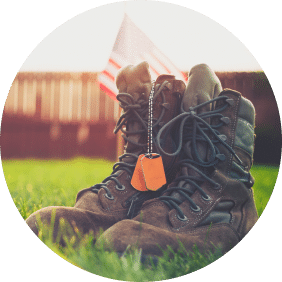Military Asbestos Exposure
Thanks to its cost and versatility, asbestos was widely used by the United States military in the 1900s. Veterans who served—particularly in World War II, the Korean War, and the Vietnam War—were all at a high risk of asbestos exposure. Veterans who have been exposed to asbestos during active duty military service and developed severe health issues like mesothelioma may qualify for VA benefits and/or damages in an asbestos lawsuit.
Members of the United States military who served between the 1930s and 1980s—particularly in World War II, Vietnam, and Korea—were likely exposed to asbestos. Asbestos is associated with several serious health issues, including cancer and mesothelioma.
Veterans who have developed chronic health issues as a result of service-related asbestos exposure may be entitled to VA disability benefits. In some cases, veterans may also have the right to seek damages for medical bills, lost earnings, and reduced quality of life in a military asbestos lawsuit.
What is asbestos?
Asbestos is a naturally occurring fibrous mineral found in rock and soil. Its fibers are strong, flexible, and resistant to heat and corrosion. Because of this, asbestos was widely used for decades in commercial and household products as well as in military applications. Asbestos is often used in:
- Fire retardants
- Insulation
- Vehicle components
- Construction materials
- Building materials
- Friction products
- Gaskets
- Coatings
Research has shown that exposure to asbestos carries significant health risks.
When asbestos-containing products are broken, damaged, destroyed, or otherwise disturbed, the mineral’s small fibers can be released into the air. When inhaled, the body can’t break them down, and they become lodged in the lung and other tissues.
Over time, and through extended exposure, the body experiences significant irritation from the asbestos, leading to fluid buildup and inflammation that causes DNA and cell damage.
Today, most uses of asbestos are banned or highly regulated in the United States. The United States military formally stopped using asbestos in the late 1970s.
How was asbestos used in the military?
Since asbestos is so versatile and has so many applications, it was widely used by all branches of the military, mostly beginning around World War II.
Everyone who served in the military between the early 1930s and 1980s, or was contracted as a civilian, could have been exposed to asbestos, even if their job did not directly involve the material. Ultimately, exposure depends largely on the branch of the military in which a veteran served as well as their job.
Asbestos in the Navy
Asbestos was perhaps most widely used by the Navy, particularly for insulating its vessels. Navy ships were covered in asbestos from bow to stern—in boiler rooms, engine rooms, mess halls, sleeping quarters, and ammunition storage rooms.
Today, all of the asbestos used on Navy ships in the 20th century has been removed or encapsulated. However, anyone who worked or spent time aboard a navy vessel during the World War II, Korea, or Vietnam eras was exposed to toxic levels of the mineral.
Asbestos in the Army
In the mid-20th century, the Army used asbestos building materials in the construction of barracks and military bases around the world. Commonly used applications in the military included:
- Drywall
- Insulation
- Piping
- Electrical wiring
- Boiler rooms
- Paint
- Plumbing systems
- Quonset huts
Service members who lived, worked, and slept in these asbestos-lined buildings were at high risk of toxic exposure, inhalation, and ingestion. The Army also provided asbestos gloves to artillerymen, used asbestos-containing dummy explosives for training exercises, and lined armored vehicles with asbestos to aid in fireproofing.
Asbestos in the Marines
Marines were most often exposed to asbestos on planes and ships that transported them to military bases around the world. Like those constructed for the Army, Marine Corps bases were heavily covered in asbestos-containing materials.
Many Marines were also exposed to asbestos on armored vehicles, like the M60 Main Battle Tanks, which were fortified with the carcinogenic mineral.
Asbestos in the Air Force
Like their counterparts in other branches, Air Force members were exposed to asbestos aboard military ships, in barracks, and on bases. Air Force radar stations were also constructed using many asbestos-containing materials. The Air Force also used asbestos on and in its planes for:
- Heat shields
- Electrical wiring
- Cockpit heat protection
- Brakes
- Engine valves
- Gaskets
- Epoxies and adhesives
Airmen, particularly those involved in mechanical work, were often exposed to high levels of asbestos during their time in the service.
What are the symptoms of asbestos exposure?
Acute symptoms of asbestos exposure include but are not limited to:
- Shortness of breath
- Wheezing
- Dry cough
- Fatigue
- Pain isolated to the shoulder or chest
- Wide, swollen fingertips
These can be signs of more serious health issues linked to asbestos exposure, including:
- Asbestosis
- Pleural mesothelioma
- Peritoneal mesothelioma
- Pericardial mesothelioma
- Testicular mesothelioma
- Lung cancer
- Lung nodules
- Ovarian cancer
- Laryngeal cancer
- Pharyngeal cancer
- Colon cancer
- Stomach cancer
- Esophageal cancer
- Bile duct cancer
- Pleural effusions
- Peritoneal effusions
- Pericardial effusions
- Pleuritis
- Atelectasis
The risk for these (and other) health issues increases the longer veterans worked with or near asbestos. Seek medical treatment immediately.

How do I know if I have been exposed to asbestos in the military?
You may have been exposed to asbestos if you served in a branch of the United States military in the mid- to late 20th century. While all service members were at risk of exposure, particularly high-risk jobs include:
- Pipe fitters
- Water tenders
- Boiler technicians
- Boilermakers
- Boiler tenders
- Artillerymen
- Machinist’s mates
- Mechanics
- Pilots
- Firemen
- Fire tenders
- Steamfitters
- Molders
- Vehicle technicians
- Aircraft control operators
- Warning radar operators
- Gunners
According to the VA, service members who worked in shipyards, mining, milling, construction, carpentry, and demolition should be tested for asbestos exposure.
By the late 1970s, the military had stopped using asbestos in its vehicle, on its bases, and in protective gear provided to its active duty servicemen and women. However, service members were still exposed to existing asbestos-containing materials until the military—particularly the Navy—began removing and encapsulating the carcinogenic mineral.
What is secondhand asbestos exposure?
Asbestos fibers, when released into the air, can easily become lodged or caught in clothing and textiles. When someone works with or around asbestos, their clothes can become covered in the mineral. When they go home for the day, the asbestos goes with them.
As a result, their family members are exposed to the carcinogen and can potentially inhale or ingest the fibers. This is known as secondhand or secondary asbestos exposure.
Secondary asbestos exposure carries the same risks as direct asbestos exposure. Over time, family members can get a buildup of asbestos fibers in their lungs or tissues. This can cause inflammation along with DNA and cell damage and lead to serious health issues like mesothelioma.
Research suggests that secondhand asbestos exposure is the primary cause of mesothelioma in women, often due to asbestos fibers brought home from husbands in the military and other high-risk jobs.
Applying for Asbestos VA Benefits
Veterans who have developed asbestos-related health issues may qualify for VA benefits. To receive benefits, you must have:
- Been diagnosed with mesothelioma or another health issue linked to asbestos exposure
- Had contact with asbestos on active duty military service
- Not been dishonorably discharged
When submitting a claim for disability benefits, you will need to provide:
- A nexus letter, confirming a connection between asbestos exposure and illness
- Service records
- Medical records
You can file a VA disability claim online, by mail, or in person at your regional VA office.
Can veterans file a lawsuit in addition to applying for VA benefits?
Yes, filing for VA benefits doesn’t preclude veterans from seeking additional compensation through an asbestos lawsuit. Typically, lawsuits seek compensation from asbestos companies and manufacturers.
In a lawsuit, veterans can seek compensation above and beyond what is awarded by the VA, including both economic damages (for financial losses) and noneconomic damages (for hard-to-value trauma like pain and suffering).
If you are a veteran who has been exposed to asbestos in the military, you must consider your legal rights and options. An experienced attorney can secure the help you need and work toward a successful and meaningful financial recovery.
- What Is Asbestos?
- How Was Asbestos Used In The Military?
- What Are The Symptoms Of Asbestos Exposure?
- How Do I Know If I Have Been Exposed To Asbestos In The Military?
- What Is Secondhand Asbestos Exposure?
- Applying For Asbestos VA Benefits
- Can Veterans File A Lawsuit In Addition To Applying For VA Benefits?


